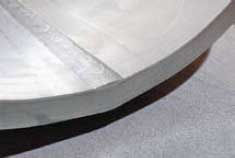Martin Connelly, Corus Tubes
Traditional carbon steel linepipes made of High-Strength, Low-Alloy (HSLA) steels exhibit corrosion rates of approximately 0.2 mm/yr under environmental conditions such as 10 bar of CO2 at 60°C, whereas Corrosion Resistant Alloy (CRA) materials exhibit 0.005 mm/yr or less under the same conditions. This means, given a 30-yr pipeline lifetime, that a 6-mm wall thickness loss would occur for HSLA steel, whereas CRA would lose less than 0.15 mm.
The increase in corrosive environments has led to an increased demand for CRAs. This is largely driven by the recent trend for exploitation of fields containing higher proportions of chloride ions, H2S and CO2. In the past, carbon steel pipe material has been used, but corrosion mitigation measures have been required during manufacture and operation of the pipeline. These measures are expensive and difficult to maintain at the required level to ensure minimal or no corrosion.
CORROSION RESISTANCE
CRAs include austenitic and martensitic stainless steels, nickel-based and titanium-based alloys. The choice of CRA will depend on the application. Materials with 11% or higher chromium are required for corrosion resistance.
For most offshore applications, CRAs on their own do not provide sufficient strength to resist hydrostatic collapse for the depths considered, or the level of strain induced during pipelay. Therefore, CRAs are used as the inner sleeve to a higher-strength outer casing.
CLAD INNOVATION
Clad linepipe is a structure in which the CRA is metallurgically bonded to the higher-strength carbon steel material during the plate rolling process. Capacity and production rates in larger diameters (more than 16 in.) are limited.
Corus has developed a process to manufacture metallurgically bonded clad pipe using what it calls the UOE method, where the material is formed into a “U,” and then an “O” shape before being expanded (“E”) to the final dimensions.
Using UOE, the company has determined a production route for the manufacture of CRA linepipe. This enables them to supply large quantities with the same dimensional and mechanical tolerances as offshore-grade carbon steel.
OPTIMAL WELD
To confirm the viability of the production route, a testing program was undertaken. In two of the trials, eight plates with carbon steel thicknesses of 15 mm and 25.4 mm and CRA (316L) thicknesses of 3.0 mm and 2.5 mm were sourced from two different plate suppliers.
Optimal welding performance is dependent on the dimensions of the plate edges. The company has invested in a new plate edge-milling machine and uses it to create a double-V preparation within the carbon steel. In addition, the CRA layer is removed to a pre-determined dimension. Accurate machining ensures excellent weld properties.
The internal and external Submerged Arc Welding (SAW) procedures used for the carbon steel backer on the clad pipes were similar to those used for carbon steel, although careful consideration was applied to the welding parameters for the internal SAW weld. This ensured a bead height of 0–0.5 mm, while maintaining the correct through-thickness profile of the internal weld bead. A defect-free SAW weld and excellent mechanical properties were achieved, Fig. 1.
 |
|
Fig. 1. Submerged arc welding ensured a bead height of 0–0.5 mm.
|
|
In partnership with Air Liquide Welding, Metal Inert Gas (MIG), twin SA, multi-pass SAW, oscillating SAW and electro-slag were considered for CRA-layer deposition on top of the internal weld. Electro-slag welding was chosen, since it achieved the required levels of quality, flexibility and productivity. The company has invested in a custom-built, multi-purpose offline welding facility for electro-slag overlay welding.
Dye penetrant examination identified any disbondment on the bevel face at the pipe ends, between the carbon steel backing material and the CRA layer, and any delamination of the CRA layer. Radiography inspected the weld seam after internal and external SAW welding and after overlay welding.
MECHANICAL PROPERTIES
The mechanical properties of representative pipes manufactured were tested. The shear strengths of over 370 MPa were determined using the ASTM A264 method; the specified minimum is 140 MPa. For all the mechanical tests except the shear test, CRA was removed by machining prior to testing.
Forward and reverse bend tests (180°) were conducted on the carbon steel base material of the pipe around an 83-mm-diameter former. No test samples showed any evidence of cracking. Hardness values of the SAW and overlay weld region were measured and comfortably passed relevant specifications (maximum Hv10 values of 227 in the SAW weld and 208 in the overlay weld). Material sensitization tests (ASTM 262 Method E) were conducted in both plate and pipe form, and both passed without issues. The 316L layer was subjected to the ferric chloride test (ASTM G48 Method A) and showed a critical pitting temperature of over 15°C for the body material.
As a result of this development work, the company has established a production process to manufacture metallurgically bonded clad pipes through a volume-based UOE pipe mill in outside diameters between 406.4 and 1,067 mm. 
|
THE AUTHOR
|
| |
Martin Connelly oversees Corus Tubes’ new product and market development. Mr. Connelly joined Corus Group in 1993 after graduating with a first-class honors degree in metallurgy and engineering materials from the University of Strathclyde in Glasgow, UK. He worked in a number of technical, quality and operational roles before being promoted to Product Development Metallurgist.
|
|




